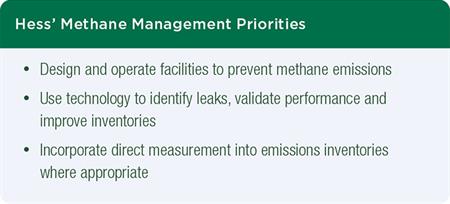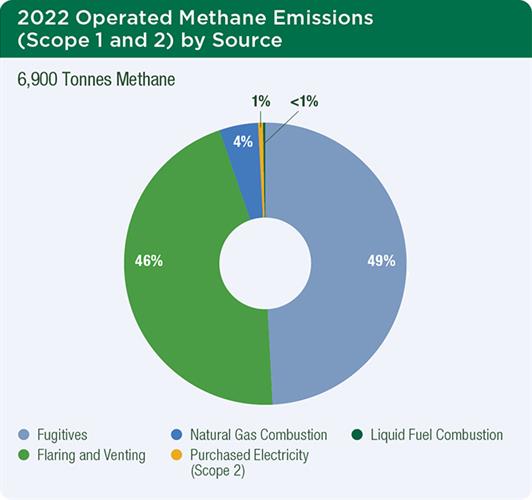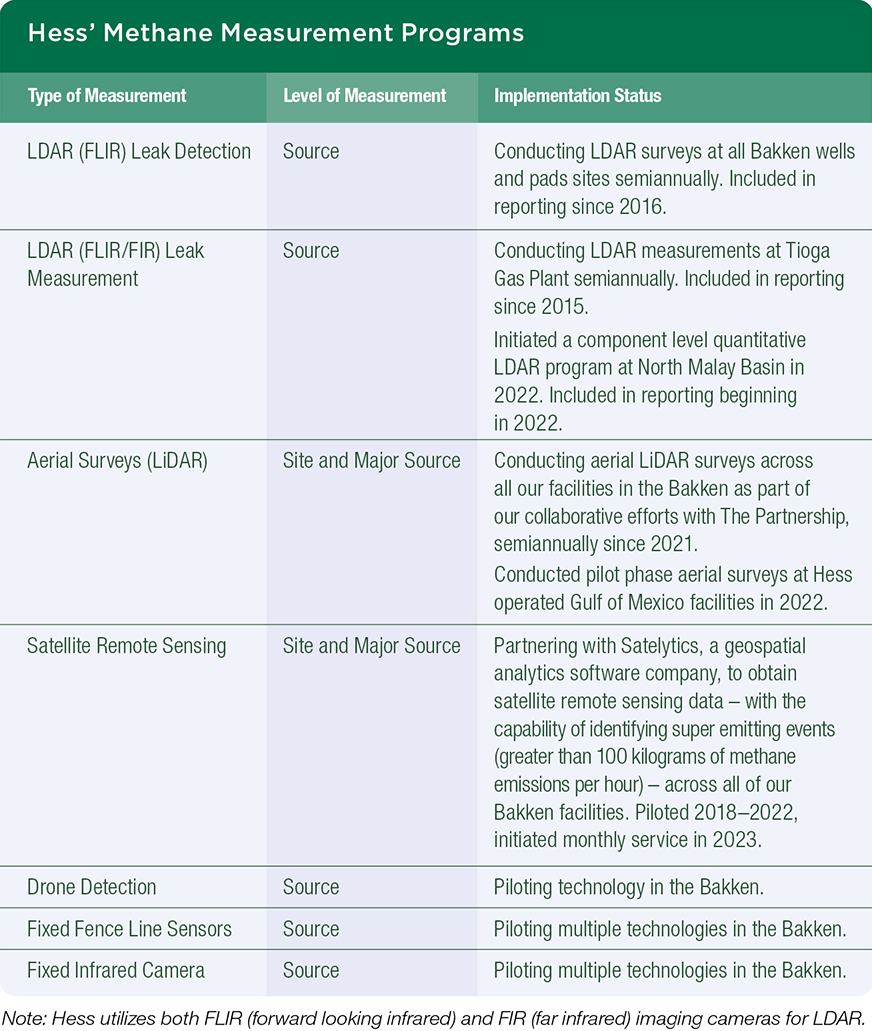Natural gas continues to play a critical role in the transition to a low carbon economy. However, there remains debate about the role that methane – the primary constituent of natural gas – and fugitive methane leakage along the natural gas value chain may have in reducing this fuel’s climate benefits. Hess, along with our trade associations and many others in the oil and gas industry, has been focused on identifying strategies to add transparency around methane emissions reporting and to address methane leakage, which are both key to realizing the benefits of natural gas as a transition fuel.
Hess supports the Global Methane Pledge to reduce methane emissions by 30% below 2020 levels by 2030, which was announced by the U.S. and European Union at the COP26 in Glasgow, Scotland. We have established our own methane emissions intensity target as part of our short term climate strategy, and our progress is discussed below. We are also a founding member of both ONE Future, a coalition of companies from the natural gas industry focused on reducing methane emissions across the value chain, and The Environmental Partnership (The Partnership), which aims to progress actions to reduce air emissions associated with natural gas and oil production. Our voluntary commitments to pursue emissions reductions through these groups are described on pages 42–43.
We believe that performance based programs such as ONE Future and The Partnership, together with individual companies’ methane emissions reduction targets, are effective at achieving voluntary reductions of methane emissions in the oil and gas industry. As part of our voluntary commitments, we have established our own methane emissions intensity reduction target and are actively exploring advancements in detection and measurement technologies that can help improve our performance and transparency, including early leak detection and enhanced emissions data quality. Hess supports the enactment of cost effective direct methane regulations that would preserve a state’s ability to adapt implementation to local conditions, and we welcome continued engagement with the U.S. government to help develop a methane rule that encourages significant methane emissions reductions while also providing producers with the flexibility needed to continue supplying reliable and affordable energy to consumers.

Emissions Performance
Our major sources of methane are fugitive emissions from pneumatic devices, pumps, tanks, compressor seals and pipelines, the residual unburned methane associated with flaring and the uncombusted methane released in the exhaust from natural gas internal combustion engines (“methane slip”).
Reducing methane emissions, which represent around 8% of our operated Scope 1 GHG emissions, continues to be a priority for Hess. In 2022, our total Scope 1 and 2 methane emissions were approximately 6,900 tonnes, which equates to approximately 172,500 tonnes of CO2e when applying a Global Warming Potential of 25 (consistent with U.S. regulatory reporting). Our methane emissions decreased by 8% from 2021 and by 28% from our 2017 baseline of 9,600 tonnes.

In 2021, Hess set a target to reduce operated methane emissions intensity to 0.19% by 2025, which equates to more than a 50% reduction in methane emissions intensity versus our 2017 baseline. As of year end 2022, we have achieved a methane intensity rate of 0.15%, surpassing our 2025 target. This result can be attributed to our continued efforts to reduce methane emissions, which include increasing natural gas capture, reducing flaring, continuing our leak detection and repair (LDAR)program and replacing and retrofitting the remaining high bleed pneumatic controllers in our North Dakota operations. This intensity rate is also a reflection of the significant strides we have made in updating our methane emissions estimation process, which are intended to keep us aligned with industry standards and help us adjust to evolving stakeholder expectations.
Although we aim to maintain this performance in support of our year end 2025 target, we recognize that significant changes are imminent due to the introduction of new measurement, reporting and verification (MRV) frameworks and protocols, such as those introduced by the Oil and Gas Methane Partnership (OGMP), GTI Veritas and the Energy Emissions Modeling and Data Lab (EEMDL). As Hess and the broader oil and gas industry adopt these MRV practices, we anticipate that inventories, metrics and targets will inevitably need to be adjusted. And we believe that as MRV practices evolve, we may have to adjust our historical inventory. Therefore, we do not believe it would be appropriate to adjust our 2025 methane intensity target until we understand the full implications of MRV related changes to our inventory.
Inventory Improvements
We have been disclosing our greenhouse gas (GHG) emissions data, including methane emissions, for over 20 years. Our aim has been to prioritize transparency by providing accurate, representative and consistent emissions data to our stakeholders, and we are constantly working to improve our emissions inventory. Over recent years we have introduced component count and leak detection based factors to our regulatory inventories. We have also worked through organizations like ONE Future and the American Petroleum Institute (API) to validate and advocate for measurement based emissions calculations in regulatory inventories.
Our GHG inventory is informed by calculation methodologies and emissions factors in the API’s GHG Compendium and the EPA’s GHG Reporting Program. Our methane emissions estimates are largely based on source level emissions factors (OGMP Level 3). In some instances, these factors incorporate gas composition data, flow rates and incident duration (OGMP Level 4), but to date we have only incorporated a limited amount of direct measurement data into our corporate inventory or regulatory submissions. In addition, although we have conducted site and basin level measurements using aircraft based light detection and ranging (LiDAR) and satellite remote sensing methods, we have not attempted to reconcile these measurements with our factor based inventory.
In 2022, we incorporated new emissions factors that better represent methane slip emissions from lean burn internal combustion engines that drive Hess Midstream’s compressors. We also included quantified gas releases from our incident reporting system. We made the following improvements to our methane emissions estimation process for our 2022 inventory and baseline:
- Adjusted our Gulf of Mexico fugitive emissions estimates to incorporate equipment based component estimates, rather than facility level throughput factors, 2017–2022 (reduction)
- Adjusted our Gulf of Mexico venting calculation to use metered gas volumes rather than equipment runtime, 2017–2022 (increase)
- Included LDAR emissions factors for all facilities conducting LDAR in North Dakota, 2022 (reduction)
- Included leak survey measurement data at our North Malay Basin facilities, 2022 (reduction)
- Updated gas combustion methane slip factors for Hess Midstream facilities, 2017–2022 (increase)
- Included methane volumes from gas releases recorded in our Incident Reporting and Investigation System, 2017–2022 (increase)
These methodology changes resulted in a 9% reduction in 2021 methane emissions and a 5% increase in our 2017 estimate.
Our current GHG emissions inventory, including methane, is verified by ERM Certification and Verification Services, and the results of their assurance effort are disclosed on page 72. As direct measurements are adopted in our reported emissions, those methods and data will be subject to the same level of assurance. We are also evaluating methane specific verification standards and services.
As material differences are identified, we plan to adjust our inventory, reevaluate our emissions baseline and intensity targets, and disclose restatements accordingly. The Hess GHG Inventory Protocol, available on our website, details our approach to materiality and explains how and why we adjust our inventory and target baseline.
We are committed to improving our methane emissions reporting to align with the newer technologies and reporting protocols that are becoming available. Along with many of our industry peers and interested stakeholders, we have invested significant time and resources to understand the limitations of our current methane inventories and to identify more accurate and cost effective ways to measure and reconcile our methane data. Collectively, we have learned that methane MRV is a complex issue and none of the key elements (measurement technologies, reconciliation protocols and reporting frameworks) are fully mature.
Measurement Reporting and Verification
In recent years, academic and industry studies have identified gaps in established regulatory methane emissions estimation protocols, and various methane measurement programs have begun to either propose alternative emissions factors or highlight the need for direct measurement in order to reflect emissions more accurately. Efforts to develop measurement and reconciliation protocols and the adoption of alternative measurement methodologies by regulators is a multiyear process. For example, protocols on site level measurement and reconciliation were only released by GTI Veritas in early 2023. We plan to evaluate MRV protocols using data from our past and future planned site level surveys.
We support the approach of using direct methane measurement to reconcile and validate emissions inventories. We do believe, however, that there are still significant challenges to the interpretation of methane measurement data, including the following:
- Many of the emerging methane measurement technologies that have the potential to increase frequency of measurement are relatively immature and have high levels of uncertainty.
- There is a lack of widely accepted reconciliation methodologies and protocols.
- Few of the measurement technologies under evaluation have regulatory equivalency.
- Regulators have been slow to adopt measurement based emissions factors, a step that will be needed before companies can fully reconcile their inventories with regulatory reporting.
In order to help address some of these concerns, we have been active in a wide range of initiatives to try to progress the adoption of methane MRV, including the following in 2022:
- Monitored and evaluated evolving methane measurement technologies through active involvement in ONE Future and the North Dakota Energy and Environmental Research Center’s Intelligent Pipeline Integrity Program
- Conducted LDAR surveys, aerial LiDAR surveys and satellite remote sensing (through a third party) to obtain site and/or source specific leak detection and methane measurement data (see table on the next page)
- Initiated simultaneous technology pilots at four sites in the Bakken (one compressor station and three well pads) in order to rapidly compare technologies, with the aim to evaluate the applicability of these different technologies for reconciliation purposes and to correlate measurements with operational activity data in order to prioritize mitigation
- Initiated trials with two data analytics software vendors that take source inventory data, measurement data and real time operations data to help predict and prevent leaks
- Supported development of the GTI Veritas measurement and reconciliation protocols through our ONE Future membership
- Met with the OGMP directly to discuss the fundamental requirements of an OGMP 2.0 commitment and indirectly through our involvement in ONE Future and Ipieca and engaged with peer companies to learn more about their OGMP implementation
- Met with representatives from the EEMDL to learn more about their plans to develop MRV tools and services and with MiQ about certification
As we conduct these methane measurement technology and service evaluations, we are considering how they would help us comply with voluntary MRV frameworks and standards and also current and anticipated regulations. OGMP 2.0 and the Oil and Gas Climate Initiative’s Aiming for Zero Methane Emissions Initiative provide frameworks for companies to develop their MRV programs. We are currently evaluating MRV protocols published by the OGMP, GTI Veritas and the EEMDL. These frameworks and protocols are not currently complementary. However, we are supporting efforts across the industry to encourage harmonization of these protocols and standards.
We acknowledge that there have been some important gaps and uncertainties in regulatory and industry methane emissions estimation protocols to date. Various methane measurement programs in recent years have begun to highlight these gaps and either propose alternative emissions factors or highlight the need for direct measurement in order to reflect emissions more accurately. Efforts to develop measurement and reconciliation protocols and the adoption of alternative measurement methodologies by regulators is a multiyear process. For example, protocols on site level measurement and reconciliation were only released by GTI Veritas in early 2023. We plan to evaluate MRV protocols using data from our past and future planned site level surveys.
